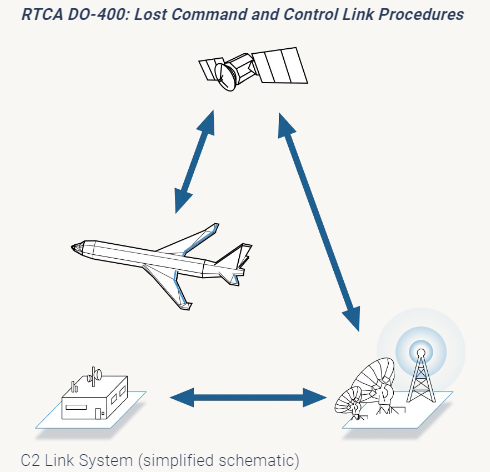Standards agency RTCA has published new guidance for Uncrewed Aircraft System (UAS) operations in the National Airspace System (NAS): DO-400.
DO-400 provides procedures for uncrewed civilian aircraft in the unlikely case that their C2 Link becomes unavailable or interrupted for an unacceptably long period of time. Although the FAA needs to formally consider DO-400 in order for it to become official regulatory guidance, this current guidance will enable the industry to develop supporting systems and operations. It is intended to provide a straightforward means to address lost link scenarios, comparable to existing procedures for loss of radio communications and in anticipation of the implementation of UAS at scale, explains a blog published by Reliable Robotics.
Ongoing advancements in the automation of commercial aviation bring about novel contingency scenarios that need solutions – a Loss of the C2 Link (commonly known as “lost link” or “LC2L”) is one of them. The C2 Link is the connection between the Uncrewed Aircraft (UA) and the Control Station, which consists of one or multiple individual datalinks to support the safety of the UAS operation and the safe integration of that UA into the airspace.
According to RTCA: “DO-400 provides guidance to stakeholders that could be affected by UAS operations that may encounter a Lost C2 Link (LC2L) while operating in the United States National Airspace System. Although worldwide UAS standards discussions identify a LC2L event as a rare event, standardized operating procedures to follow when/if this type of event occurs have yet to be established.”
Reliable Robotics Systems Engineer Martin Koschel participated in the RTCA Subcommittee 228 Working Group 3 (SC-228 WG 3), which was tasked with developing this guidance material. They are a group composed of members from multiple sectors of the industry, such as vehicle and systems manufacturers, engineering and communications service providers, and government entities like the FAA and NASA. According to the blog prepared by Martin Koschel for Reliable Robotics:
“Government-operated UAS have been flying in the NAS for over a decade. To date, the FAA has had to document aircraft-specific procedures in lengthy waivers on a case-by-case basis. The implementation of DO-400 by designers and the FAA would standardize procedures to the point that aircraft-specific waivers are not needed, and, in the unlikely case of an LC2L, everyone in the airspace will have confidence in the behaviour of the UA – without even having to know what type of aircraft it is or who is operating it. ICAO has developed high-level requirements (called SARPs and PANS) for Remotely Piloted Aircraft Systems (RPAS); however, more detail was required from a designer’s perspective to implement those procedures in a uniform way, which is where RTCA picked up the work.
“It was informative to discuss and analyse future UAS operations from varying perspectives. ICAO’s Remotely Piloted Aircraft Systems Panel (RPASP) proceedings were considered as well. The group started with the foundational principle that predictability is a critical aspect of safe aviation operations. Therefore, we worked to ensure that the behaviour of the UA as it follows the proposed procedure would appear to other pilots and ATC as predictable. During the collaborative effort, the problem was systematically examined, and gaps were identified by a team that included pilots, air traffic controllers, engineers and communication system experts. All phases of flight, from taxi, through takeoff roll, departure, transit/extended ops (en route), to arrival, approach, and landing, including rollout, were considered. The document also provides recommendations for the verification and validation of LC2L procedures.
“The most challenging part of developing DO-400 was to build upon existing operating practices and transform them into the novel context of autonomous operations under the specific conditions of a lost C2 link scenario. Many permutations of “what if” had to be evaluated to make sure the document has broad coverage and is not unduly operationally restrictive,” concludes Reliable Robotics.
(Image: RTCA DO-400: Lost command and control link procedures)
For more information visit:




